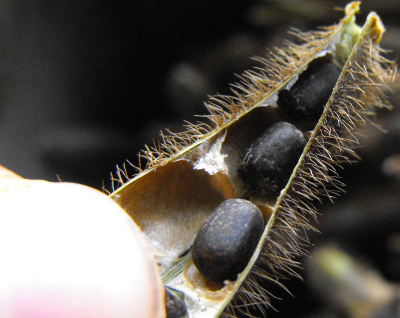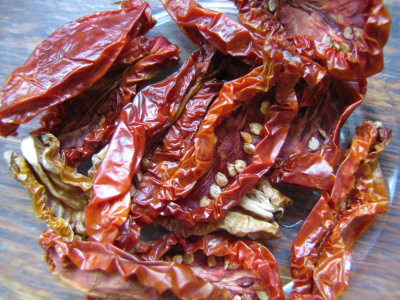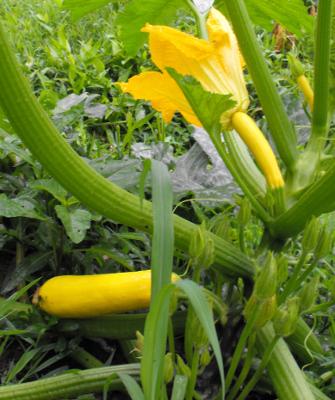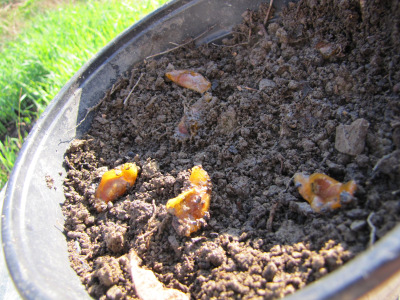
2010 garden experiments
 After
four years of hard-core gardening, the vegetable garden doesn't require
much experimentation any more. I've mostly figured out when to
plant our crops, which varieties grow well in our soil, and how to
fight the worst diseases and pests. I do keep trying out new
experimental varieties, but I've discussed this year's successes and
failures previously (for example: amaranth, urd beans, other
experimental beans,
and quinoa,
sesame, and poppies.)
In this post, I just want to sum up our dealings with some of the
thornier issues --- how to
keep tomatoes from getting blight, how to keep cucurbits from dying of
anything and everything, and some work with woody plants.
After
four years of hard-core gardening, the vegetable garden doesn't require
much experimentation any more. I've mostly figured out when to
plant our crops, which varieties grow well in our soil, and how to
fight the worst diseases and pests. I do keep trying out new
experimental varieties, but I've discussed this year's successes and
failures previously (for example: amaranth, urd beans, other
experimental beans,
and quinoa,
sesame, and poppies.)
In this post, I just want to sum up our dealings with some of the
thornier issues --- how to
keep tomatoes from getting blight, how to keep cucurbits from dying of
anything and everything, and some work with woody plants.
 2009
was the year without a tomato,
when every tomato in the eastern U.S. seems to have been impacted by
blight. We adore tomatoes, so we tried a lot of techniques to
keep our plants blight-free in 2010, including pruning
tomatoes to keep their leaves away from the damp soil, ripping
out any plants that contract the fungus, planting
blight-resistant tomato varieties, scattering
tomatoes throughout the garden and planting some later in the year, and weeding out
volunteer potatoes and weedy nightshades that can harbor the blight.
The combination of factors all added up to a good tomato year, despite
blight spores wafting through the air, although I don't think that the
tomato islands and succession planting did much good. We put away
enough tomatoes for pizza and spaghetti sauce, soups, and general
cooking to last us through the winter, and the only thing I would have
done differently would be to start drying
tomatoes earlier in
the year so we could have more of those delicious treats!
2009
was the year without a tomato,
when every tomato in the eastern U.S. seems to have been impacted by
blight. We adore tomatoes, so we tried a lot of techniques to
keep our plants blight-free in 2010, including pruning
tomatoes to keep their leaves away from the damp soil, ripping
out any plants that contract the fungus, planting
blight-resistant tomato varieties, scattering
tomatoes throughout the garden and planting some later in the year, and weeding out
volunteer potatoes and weedy nightshades that can harbor the blight.
The combination of factors all added up to a good tomato year, despite
blight spores wafting through the air, although I don't think that the
tomato islands and succession planting did much good. We put away
enough tomatoes for pizza and spaghetti sauce, soups, and general
cooking to last us through the winter, and the only thing I would have
done differently would be to start drying
tomatoes earlier in
the year so we could have more of those delicious treats!
 We
also mostly licked our cucurbit problems. In the past, we've lost
many of our squashes to vine borers and our cucumbers and melons to
wilts and blights, and we've tried lots of complicated methods to solve
these problems. In the end, it seems like the lowest tech answers
are the best when it comes to cucurbits. Among winter squashes,
we simply converted
over to an all-butternut garden, which deleted all of the
issues and also fed us the tastiest of the winter squashes. For
summer squashes, we settled on succession
planting, seeding a
new bed May 1, May 15, June 1, June 15, July 15, and July 30. As
soon as the earlier bed succumbed to vine borers, the next bed was
producing, and our freezer is chock full of squash slices. We
used nearly the same succession planting technique with cucumbers, with
the addition that we chose a more mildew-resistant variety (Diamont
Hybrid), and for the first time we were overrun with cucumbers for most
of the summer. We had a so-so watermelon year, but the problem
there was mislabelled seeds. In the end, the only cucurbit that
still eludes me is canteloupes --- since these plants need a long
growing season like winter squash, I can't just succession plant to
beat the blight. Maybe some research will turn up a more
resistant variety, or perhaps I'll follow my movie star neighbor's lead
and plant canteloupes atop black plastic for faster drying.
We
also mostly licked our cucurbit problems. In the past, we've lost
many of our squashes to vine borers and our cucumbers and melons to
wilts and blights, and we've tried lots of complicated methods to solve
these problems. In the end, it seems like the lowest tech answers
are the best when it comes to cucurbits. Among winter squashes,
we simply converted
over to an all-butternut garden, which deleted all of the
issues and also fed us the tastiest of the winter squashes. For
summer squashes, we settled on succession
planting, seeding a
new bed May 1, May 15, June 1, June 15, July 15, and July 30. As
soon as the earlier bed succumbed to vine borers, the next bed was
producing, and our freezer is chock full of squash slices. We
used nearly the same succession planting technique with cucumbers, with
the addition that we chose a more mildew-resistant variety (Diamont
Hybrid), and for the first time we were overrun with cucumbers for most
of the summer. We had a so-so watermelon year, but the problem
there was mislabelled seeds. In the end, the only cucurbit that
still eludes me is canteloupes --- since these plants need a long
growing season like winter squash, I can't just succession plant to
beat the blight. Maybe some research will turn up a more
resistant variety, or perhaps I'll follow my movie star neighbor's lead
and plant canteloupes atop black plastic for faster drying.
 I've learned a lot about
propagating perennials this year, too, but was much less successful
with my first attempts. I easily got
hardy kiwis to root from softwood cuttings, but then transplanted them
straight into the unirrigated part of the garden when their roots were
too small, and the plants promptly kicked the bucket. Since the
original kiwi vines seem to have really taken off this year (their
second full summer in the ground), I figure I'll have a lot more
material to root next year and can try again. I also completely
failed at starting
various trees from seed since I didn't count on
their slow germination and lost track of exactly where I'd planted
them. This year, I'm starting
seeds that need stratification in pots, and also plan to put down a
kill mulch and start a little nursery area up by the water tank.
I've learned a lot about
propagating perennials this year, too, but was much less successful
with my first attempts. I easily got
hardy kiwis to root from softwood cuttings, but then transplanted them
straight into the unirrigated part of the garden when their roots were
too small, and the plants promptly kicked the bucket. Since the
original kiwi vines seem to have really taken off this year (their
second full summer in the ground), I figure I'll have a lot more
material to root next year and can try again. I also completely
failed at starting
various trees from seed since I didn't count on
their slow germination and lost track of exactly where I'd planted
them. This year, I'm starting
seeds that need stratification in pots, and also plan to put down a
kill mulch and start a little nursery area up by the water tank.
This post is part of our 2010 experiments lunchtime series.
Read all of the entries:
|
Want more in-depth information? Browse through our books.
Or explore more posts by date or by subject.
About us: Anna Hess and Mark Hamilton spent over a decade living self-sufficiently in the mountains of Virginia before moving north to start over from scratch in the foothills of Ohio. They've experimented with permaculture, no-till gardening, trailersteading, home-based microbusinesses and much more, writing about their adventures in both blogs and books.
Want to be notified when new comments are posted on this page? Click on the RSS button after you add a comment to subscribe to the comment feed, or simply check the box beside "email replies to me" while writing your comment.

For the tomatoes, the factor that I think was the most important was just being hyper-vigilant and removing any sign of blight when you first see it. The pruning and planting in full sun probably helped a lot too, though.
For cucurbits, succession planting doesn't need to take too much extra space. The Diamant hybrid cucumber is supposed to take about six weeks to start producing fruit, and then is produced for perhaps a month before it kicked the bucket. So it really only requires about double the space as planting a cucumber that produces all season. You might try slipping some late cucumbers and squash in after your garlic comes out of the ground...